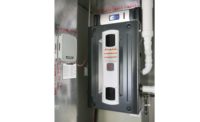Just like customers expect a doctor to be an expert in health care, a lawyer to be an expert in law, and a banker to be an expert in finance, they expect their HVAC technician to be an expert in IAQ. And that’s where whole-house humidification systems come into play. The optimum humidity level in a home depends on personal preferences, clothing, and physical activity, but ASHRAE suggests a range of 45-55 percent humidity to manage health effects and illnesses.
HVAC contractors who are privy to this information are encouraging homeowners to install humidification systems in their homes. And by educating customers on the benefits, such as lower maintenance costs and higher occupant health and comfort levels, they’re finding that the systems basically sell themselves.
EDUCATE
Whole-house humidification systems are designed to increase comfort and decrease health-related issues and risks. When entering a customer’s house, the first step in making a successful sale is to properly inform customers on the overall benefits of a whole-house humidifier.
Travis Smith, owner, Sky Heating & Air Conditioning, Portland, Oregon, said he and his technicians bring specification sheets with them to customers’ homes.
“We have in-house spec sheets that we made up for our sales people, service techs, and customers that list all of the benefits and electrical requirements of the humidification systems we offer,” he said. “Eventually, we plan on putting up YouTube videos to show the benefits as well.”
An easy way to start a conversation on the benefits of a whole-house system is by addressing customers’ complaints and explaining how the system can improve their issues.
“The health benefits usually address their complaints,” said Eric Knaak, vice president and general manager, Isaac Heating & Air Conditioning, Rochester, New York. “Static electricity from carpets and clothing, dry noses or nose bleeds from nasal passages drying out, sore throats, allergies — all of those issues we hear about. Low humidity can impact all of those issues mentioned, and as indoor air professionals, we need to have a solution to provide them with, which is whole-house humidification systems.”
Next, potentially harmful outcomes from poorly-controlled humidity levels are explained to homeowners to shine a light on the importance of IAQ and why humidifiers can make a difference — especially for parents who live in harsh winter conditions.
“Explaining to parents that when humidity levels are too low, it can aggravate symptoms of asthma, rhinitis, and respiratory infections is a big factor and selling point in all IAQ sales,” said Smith. “Having a two-and-a-half-year-old in the house, I recognize the air quality is incredibly important, since children take in more air per pound of body weight, as compared to an adult — up to five times the rate.”
Steve Moon, president of Moon Air Inc. in Elkton, Maryland, said being proficient in IAQ allows a contractor to better explain to parents why a whole-house humidification system will improve their children’s health and, as a result, makes it easier to make the sale.
“I am the self-proclaimed asthma king of the world, so I am very passionate about proper humidification,” he said. “Being an IAQ expert sets you far in front of your competition because most contractors don’t even bring it up to customers. But customers, especially parents, appreciate it.”
Once health benefits are explained, contractors go into the potential energy savings that occur when installing a whole-house system.
“When explaining energy-saving benefits to customers, we have some data that shows how a human is comfortable at a lower temperature by typically 2° to 3°F when the air has the proper humidity, and this naturally results in less furnace usage, lower operating costs, and overall energy savings,” said Butch Welsch, owner, Welsch Heating & Cooling Co., St. Louis.
Most contractors have found that explaining energy savings using examples and layman’s terms helps to better make the sale every time.
Knaak finds that by explaining the evaporation process to a homeowner in an easy-to-understand manner, he is able to break down for a customer why they will save on energy costs when installing a humidification system.
“By humidifying the air, you slow down the evaporation process from the surface of the skin, and going back to high school science classes, evaporation is a cooling process,” he said. “So, by slowing down evaporation, as the air looks for moisture, you are able to stay more comfortable in your home with the thermostat a few degrees lower — a direct energy savings.”
Corey Hickman, owner, Comfort Matters Heating & Cooling Inc., Hanover, Minnesota, explains energy savings to his customers in terms of the temperature and thermostat, something they know and understand already.
“I tell them the home feels warmer in the winter, so you can set it lower,” he said. “We say in the summer, every 5 percent you can lower relative humidity feels 1° cooler.”
Moon likes to provide customers with a scenario they can relate to in order to better illustrate why making the switch to a whole-house system is
worth it.
“I love to tell the story about how it is to work in your yard on a 100° day with low humidity,” he said. “You can work all day in those conditions; however, on a high-humidity day, there are health warnings, and it is just too hot to stay out for long. So, with proper humidification, we can trick your body, set the thermostat lower, and you feel just as warm while saving on your energy bills and loving life.”
MAKING THE SALE
After explaining health and energy benefits, contractors look to execute the sale by explaining how the system works, which is often successful. A customer may feel that having their portable humidifier is enough, but it is the contractor’s job to explain that with a low-humidity situation, the whole-house humidifier can connect to a furnace and work with the heating system to distribute moisture throughout the home — a simple, more efficient and effective solution for the entire home.
“Often, homeowners have tried small, portable, one-room humidifiers,” said Welsch. “That can actually help us sell a whole-house humidifier, though, because in the room where they’re located, the customer can usually tell the benefits and notice the difference in the remote parts of the home. We have to explain that one of the reasons a single-room humidifier doesn’t work better is because humidity tends to equalize in a home faster than temperature. Therefore, the small amount of humidity put out by a one-room humidifier doesn’t provide a great deal of benefit.”
Smith sells whole-house systems versus portable humidifiers by telling customers who like the way one room feels because of the small humidifier to imagine what the whole-house system can do for every room.
“Explaining how the whole-house humidification system works is a must, of course, especially when you see multiple portable humidifiers around the house that only add one gallon per day, and the house is still dry,” he said.
Knaak makes the sale by sharing with customers that every home is different and their humidification needs are unique.
“Two homes made exactly the same and sitting side-by-side may not experience the same issues,” he said. “For example, one house has two people living in there, and they eat out a lot, whereas the other house has six people, and they cook all of the time. They are constantly introducing moisture into the air from showers and laundry as well as water that is boiled for cooking. The humidifier is a whole-house humidification system that connects to the central heating system so that whenever the furnace is operating and the humidity level is below the set point, it will automatically add moisture.”
Overall, most contractors said they don’t have to do too much convincing to successfully sell whole-house humidification systems to customers and that they practically sell themselves.
“We have a very high close rate on humidifier systems,” said Welsch. “The symptoms practically sell the need for the humidifier. Then, all we have to do is sell ourselves.”
But, while some have had great success selling whole-house humidification systems, there has still been some pushback concerning price.
“It’s still fairly rare, but the cost can be significantly higher than the customer expects by the time we have to tap into the water supply line and install a new 220V circuit as well as the ducting and control needs,” said Smith.
In order to combat that resistance, Knaak has seen a high success rate in selling humidification systems to customers in conjunction with a furnace.
“When we quote a humidifier with a system or a furnace, which we do most of the time since the cost to the client is much lower at the time of installation as opposed to us having to come back later, 50-70 percent of clients have the humidifier installed,” he said.
Moon said the success rate of selling humidification systems is so high that every contractor should be pushing to make the sale every time.
“We have about a 60 percent success rate,” he said. “People want this stuff. Don’t be stupid and miss the opportunity. The big-box stores are happy to take the sales opportunity away from you.”
Publication date: 4/23/2018













